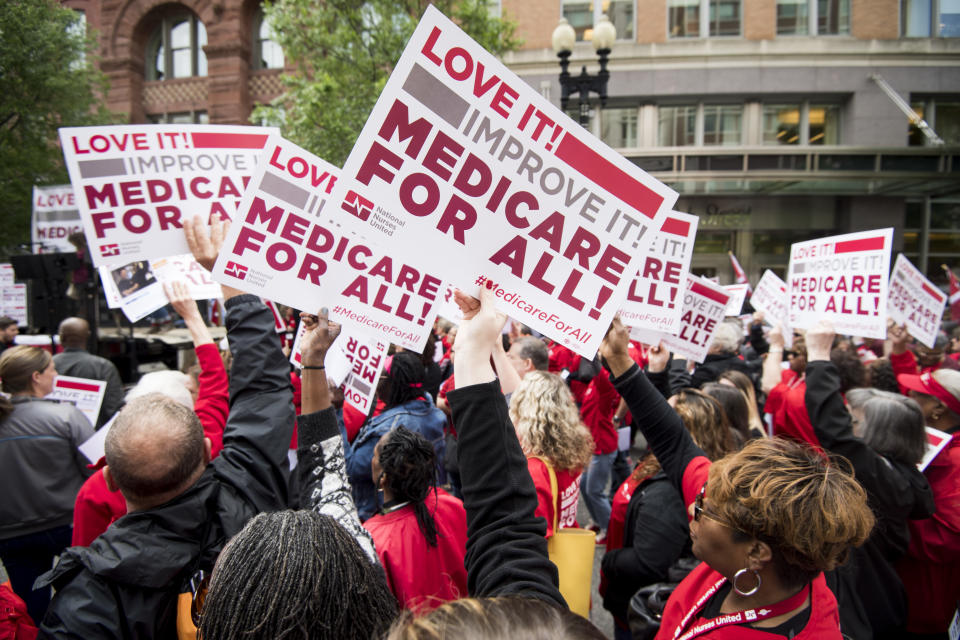Obamacare is working
Six years after its tumultuous rollout, the Affordable Care Act is finally working more or less as intended.
Presidential contenders should take notice. Obamacare, as the ACA is known, offers many lessons for politicians aiming to shake up the health care system, whether it’s doing away with private insurance, as Elizabeth Warren and some other Democrats want to do, or hacking away at protections the ACA itself now offers, as President Trump is attempting.
About 20 million Americans have gained health care coverage through the ACA, split roughly evenly between people who get new subsidies to buy private coverage and the expansion of Medicaid in 33 states. The uninsured rate has dropped from 19.3% before the ACA to 12.4% now.
When most of the law’s provisions went into effect in 2014, insurers participating in the ACA weren’t sure how many people would sign up, or how sick or healthy they would be. That made it hard to set rates, and there were large swings in premiums in the early years of the program, to compensate for mispricing in prior years. In some markets, insurers pulled out of the ACA, leaving a lack of competition allowing remaining insurers to hike premiums. Some critics claimed Obamacare was in a “death spiral,” with rising premiums and departing insurers compounding problems to the point of driving everybody away.
That hasn’t happened. Instead, premiums have stabilized and patients and insurers have stuck around. Premiums for a typical “benchmark” plan are rising just 1% for 2020. That’s less than the rate of inflation. In some areas, ACA premiums will actually decline. Enrollment has remained steady, even though the Trump administration has cut funding for promotion, patient outreach and other things meant to make the ACA run smoothly.
“The Affordable Care Act’s individual market health insurance exchange appears to be experiencing some semblance of stability,” analysts at the right-leaning American Action Forum wrote recently. “Coming into 2020, the exchange is entering its second straight year of only marginal premium fluctuation, indicating a less volatile marketplace.”

Despite this, Trump—who campaigned on repealing the ACA—is still trying to kill it. The Trump administration is party to a lawsuit originating in Texas that claims the ACA is unconstitutional since Congress repealed the “individual mandate” requiring all people to have insurance in 2017. The logic of the lawsuit isn’t intuitive, yet an appeals court hearing the case has suggested they could side with the plaintiffs and invalidate the ACA. That ruling could come any day and would undoubtedly land at the Supreme Court next.
If courts rule against the ACA, Trump would have some ‘splaining to do. Americans strongly favor some parts of the law, especially the ban on insurance companies denying coverage or charging more to people with pre-existing conditions. Nearly 54 million Americans under age 65—27% of that population—could face coverage limitations if insurers are once again allowed to single them out. Trump says he’d take care of that, but he has no plan and Congressional efforts to replace the ACA with something else have failed repeatedly and embarrassingly.
The right amount of change
Democrats running for president feel emboldened to press for further changes in the health care system, to address persistent problems: Twenty-eight million Americans remain uninsured, and out-of-pocket costs for those with insurance have been rising far faster than incomes. While the uninsured rate has dropped sharply, the “underinsured rate”—the portion of people who have coverage but find it unaffordable—has gone up.
The ACA offers warnings and insights on how much change Americans will tolerate to deal with those issues. Obamacare got off to a rocky start because roughly 3 million people lost their existing coverage when the new ACA requirements went into effect. In many cases, those people were paying discounted rates for limited coverage that no longer complied with the law, and they ended up paying more for deeper coverage they didn’t feel they needed. That disruption made the ACA unpopular out of the gate, with an approval rating that bottomed at 33% in late 2013.
Some Democratic proposals today would be far more disruptive than that, especially the “Medicare for all” plan Senators Elizabeth Warren and Bernie Sanders support. Since it would end private insurance, MFA would basically take 160 million people off existing plans and move them into a government program. Some might feel better off, but others who are happy with their coverage now undoubtedly would not. And that would amount to multiples of the 3 million people who lost their coverage under Obamacare.
The ACA is now modestly popular, with an approval rating of 52%. Yet the law’s early flaws left it vulnerable to attack and could still undo it, if courts rule against the ACA. To avoid this upheaval, the next effort to revamp the U.S. health care system should follow the old physicians’ adage—first, do no harm—and leave parts of the system that are working alone. Other changes should phase in gradually, with plenty of warning time and recompense for people who feel short-changed. That sort of plan might be popular from the start.
Rick Newman is the author of four books, including “Rebounders: How Winners Pivot from Setback to Success.” Follow him on Twitter: @rickjnewman. Confidential tip line: rickjnewman@yahoo.com. Encrypted communication available. Click here to get Rick’s stories by email.
Read more:
Why Elizabeth Warren is triggering billionaires
The biggest myth of the Trump economy
The staggering cost of Elizabeth Warren’s plans: $4.2 trillion per year
Why Democrats bomb with rural voters
4 problems with Andrew Yang’s free money drop
Read the latest financial and business news from Yahoo Finance
Follow Yahoo Finance on Twitter, Facebook, Instagram, Flipboard, SmartNews, LinkedIn, YouTube, and reddit.


